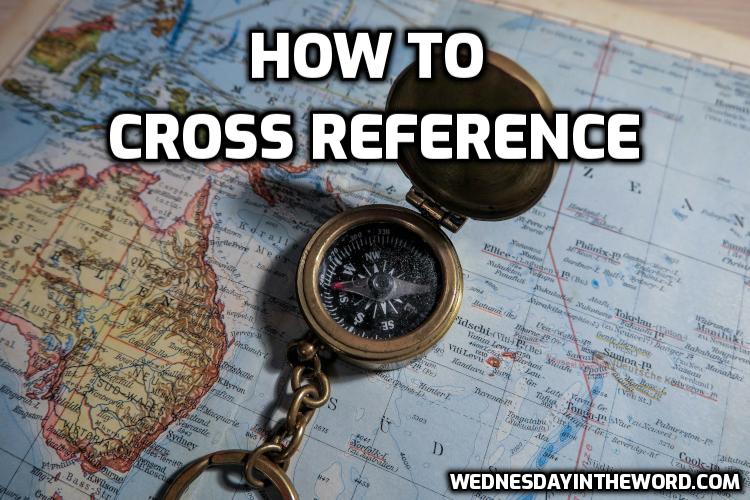Bottom line: Let the Bible clarify the Bible. Cross-references highlight places where another passage speaks to the same idea, so the clearer passage helps us understand the less clear. Start close (same author, same theme), then widen your lens.
Why Cross References Matter
- The Bible is repetitive. The same themes appear in multiple books and passages and across multiple authors. For example, Jesus, James, Peter, and Paul all make that point (John 15:17–21; James 1:1–5; 1 Peter 1:6–7; Romans 5:3–5).
- Comparing what they say helps you trace a theme and avoid importing ideas that aren’t in the text.
- Used wisely, cross-references protect you from cherry-picking and keep interpretation anchored in the author’s intent.
A simple 4-step workflow
Step 1: Start near: same author, same theme
If you’re in Ephesians, check Paul’s other letters on the same question/argument before you roam. Look for shared key terms and repeated reasoning.
If you’re new to Bible Study, you might want to start with Bible Study 101.
Step 2: Test the relevance
Ask three quick questions before you add a cross-reference to your notes:
- Is this passage addressing the same question?
- Is this passage making the same argument?
- Does it share key terms and a clear conceptual parallel? (Using the same word alone is not enough to establish a cross-reference.)
If the answer is “not really,” keep it in the margin, don’t build on it.
Step 3: Let the clear interpret the obscure
When passages genuinely speak to the same idea, use the clearer one to illumine the harder one. Don’t flatten differences. Use the differences to help you understand the broader implications of the topic.
Lists of where Scripture quotes Scripture
How to use e-sword as a concordance
Step 4: Trace the thread across Scripture
After you have explored the near-context, widen your search to the rest of the Bible. Use your tools and references (study Bibles, dictionaries, concordances) to find potential passages, but test them with Step 2.
Lists of where Scripture quotes Scripture
Bible Study Tools #1: Translations
Bible Study Tools #3: Concordances
Bible Study Tools #4: Lexicons & Dictionaries
Bible Study Tools #5: Multi-volume Encyclopedias
How to find strong cross-references (without getting lost)
Look at the cross-reference system in your study Bible. Start with in-margin references; follow the ones that look most relevant, not every link. (Pair with a dictionary/encyclopedia when terms are unfamiliar.
Bible Study 101: Interpretation
Use a physical or online concordance. Search key words from the verse (e.g., “reconcile,” “veil,” “new creation”).
Bible Study Tools #3: Concordances
Same author first: If you’re in Peter, check Peter; in John, check John’s Gospel/letters; in Paul, check his other letters for the same theme.
Resources by Book of the Bible
Types of cross-references you’ll meet
- Quotation or explicit citation. An author quotes a verse (e.g., “as it is written”). This is the strongest type of link.
- Allusion or echo. Shared wording or imagery points back to an earlier text (e.g., “new covenant,” “jars of clay”). Treat these as probable links; confirm with context.
- Conceptual parallel. Same idea, different words (e.g., justification by faith in different books). These require more care. Test relevance (Step 2) before drawing conclusions.
- Narrative parallel. Similar events or patterns (e.g., exodus imagery applied to salvation). Use to illuminate theme, not to force 1:1 detail mapping.
What to write in your notes
- Reference (Book chapter:verse) + a descriptive label for why it’s relevant. Example: Romans 5:1 — implications of being justified.
- One sentence on how it clarifies your passage.
- Type of References tag: Q (quotation), A (allusion), C (concept). This keeps your cross-refs concise and accountable.
Common pitfalls (and how to avoid them)
- Word-only matches: Same word, different meaning (e.g., righteousness is used at least 3 different ways in Scripture). Check author and context.
- Distant links too soon: Don’t skip your passage’s own flow of thought. Trace the logic locally first.
How to Do an Analytical Outline
- Doctrinal shopping: Picking supportive verses without testing for relevance first. Use the “same question / same argument / same terms?” test.
- Quantity ≠ quality: Two strong cross-refs beat twenty weak ones.
Mini-FAQ
What if cross-references seem to disagree?
Look at the question each author is answering. Different questions can yield different emphases without contradiction. Start with the clearest on your topic, then revisit the harder text.
When should I use cross-references in my study?
After you’ve done basic observation and summarized the author’s main point. Use cross-referencess to confirm/clarify, not to replace close reading and observation.
Which tools do you recommend?
A study Bible with good in-margin references, a Bible dictionary/encyclopedia, and a concordance/search tool.
Try it now (5-minute practice)
- Choose one paragraph you’re studying.
- Write your 1–2 sentence big idea.
- Find two cross-references: one by the same author, one from elsewhere.
- In one sentence each, note how they clarify your paragraph.
- Keep only the ones that pass the relevance test.
Keep learning
- How to Study Epistles: full step-by-step (see Step 5 on cross-references)
- Bible Study Starter Kit : 10 Rules, 5 Questions, and 5-Step Method
- Tools: dictionaries, encyclopedias, concordances & more.
- Bob Smith’s Basics of Bible Interpretation: a free, beginner-friendly primer
- PreceptsAustin Observation
- Bible Study 101: Reading List
Photo by Denise Jans on Unsplash
62
